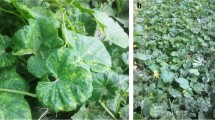Abstract
Geminiviruses cause considerable yield loss in several crop plants worldwide. In 2016, several hollyhock plants displaying yellow mosaic and leaf curling symptoms were noticed in a nursery of Jawaharlal Nehru University, New Delhi, India. Analysis of the collected samples indicated an association of monopartite and bipartite begomoviruses with satellites. Three begomoviruses (including a member of a new begomovirus species), two alphasatellites, and a betasatellite were isolated from yellow-mosaic-disease-affected plants. Similarly, a begomovirus, two alphasatellites, and a betasatellite were found to be associated with leaf curl disease of hollyhock. These begomoviruses and satellites were found to be recombinants. By harboring diverse begomoviruses and satellite DNAs, hollyhock may serve as a potential source of virus inoculum.


Similar content being viewed by others
References
Ara MR, Masud MMH, Akanda AM (2012) Detection of plant viruses in some ornamental plants that act as alternate hosts. Agriculturists 10(2):46–54
Navas-Castillo J, Fiallo-Olive E, Sanchez-Campos S (2011) Emerging virus diseases transmitted by whiteflies. Annu Rev Phytopathol 49:219–248
Rojas MR, Hagen C, Lucas WJ, Gilbertson RL (2005) Exploiting chinks in the plant’s armor: evolution and emergence of geminiviruses. Annu Rev Phytopathol 43:361–394
Gnanasekaran P, Kumar RK, Bhattacharyya D, Kumar RV, Chakraborty S (2019) Multifaceted role of geminivirus associated betasatellite in pathogenesis. Mol Plant Pathol 20(7):1019–1033
Kumar RV (2019) Plant antiviral immunity against geminiviruses and viral counter-defense for survival. Front Microbiol 10:1460
Kumar RV, Singh AK, Singh AK, Yadav T, Basu S, Kushwaha N, Chattopadhyay B, Chakraborty S (2015) Complexity of begomovirus and betasatellite populations associated with chilli leaf curl disease in India. J Gen Virol 96:3157–3172
Kumar RV, Singh D, Singh AK, Chakraborty S (2017) Molecular diversity, recombination and population structure of alphasatellites associated with begomovirus disease complexes. Infect Genet Evol 49:39–47
Briddon RW, Bull SE, Mansoor S, Amin I, Markham PG (2002) Universal primers for the PCR-mediated amplification of DNA β: a molecule associated with some monopartite begomoviruses. Mol Biotechnol 20:315–318
Muhire BM, Varsani A, Martin DP (2014) SDT: a virus classification tool based on pairwise sequence alignment and identity calculation. PLoS One 9:e108277
Kumar S, Stecher G, Li M, Knyaz C, Tamura K (2018) MEGA X: molecular evolutionary genetics analysis across computing platforms. Mol Biol Evol 35:1547–1549
Martin DP, Murrell B, Golden M, Khoosal A, Muhire BM (2015) RDP4: detection and analysis of recombination patterns in virus genomes. Virus Evol 1(1):vev003
Brown JK, Zerbini FM, Navas-Castillo J, Moriones E, Ramos-Sobrinho R et al (2015) Revision of Begomovirus taxonomy based on pairwise sequence comparisons. Arch Virol 160:1593–1619
Zerbini FM, Briddon RW, Idris A, Martin DP, Moriones E, Navas-Castillo J, Rivera-Bustamante R, Roumagnac P, Varsani A, IR Consortium (2017) ICTV virus taxonomy profile: Geminiviridae. J Gen Virol 98:131–133
Briddon RW, Martin DP, Roumagnac P, Navas-Castillo J, Fiallo-Olive E et al (2018) Alphasatellitidae: a new family with two subfamilies for the classification of geminivirus- and nanovirus-associated alphasatellites. Arch Virol 163:2587–2600
Briddon RW, Navas-Castillo J, Fiallo-Olive E, on behalf of the Geminiviridae study group (2016) https://talk.ictvonline.org/ictv/proposals/2016.021a-kP.A.v2.Tolecusatellitidae.pdf
Lefeuvre P, Moriones E (2015) Recombination as a motor of host switches and virus emergence: geminiviruses as case studies. Curr Opin Virol 10:14–19
Lefeuvre P, Lett JM, Reynaud B, Martin DP (2007) Avoidance of protein fold disruption in natural virus recombinants. PLoS Pathog 3:e181
George B, Alam CM, Kumar RV, Gnanasekaran P, Chakraborty S (2015) Potential linkage between compound microsatellites and recombination in geminiviruses: evidence from comparative analysis. Virology 482:41–50
Bigarre L, Chazly M, Salah M, Ibrahim M, Padidam M, Nicole M, Peterschmitt M, Fauquet C, Thouvenel JC (2001) Characterization of a new begomovirus from Egypt infecting hollyhock (Althea rosea). Eur J Plant Pathol 107:701–711
Singh BP, Misra AK (1971) Occurrence of hollyhock yellow mosaic virus in India. Indian Phytopathol 24:213–214
Srivastava A, Kumar S, Raj SK, Pande SS (2014) Association of a distinct strain of Hollyhock yellow vein mosaic virus and Ludwigia leaf distortion betasatellite with yellow vein mosaic disease of hollyhock (Alcea rosea) in India. Arch Virol 159:2711–2715
Pratap D, Kashikar AR, Mukherjee SK (2011) Molecular characterization and infectivity of a Tomato leaf curl New Delhi virus variant associated with newly emerging yellow mosaic disease of eggplant in India. Virol J 8:305
Zaidi SS, Martin DP, Amin I, Farooq M, Mansoor S (2017) Tomato leaf curl New Delhi virus: a widespread bipartite begomovirus in the territory of monopartite begomoviruses. Mol Plant Pathol 18(7):901–911
Ranjan P, Kumar RV, Chakraborty S (2013) Differential pathogenicity among Tomato leaf curl Gujarat virus isolates from India. Virus Genes 47(3):524–531
Jyothsna P, Haq QMI, Singh P, Sumiya KV, Praveen S, Rawat R, Briddon RW, Malathi VG (2013) Infection of tomato leaf curl New Delhi virus (ToLCNDV), a bipartite begomovirus with betasatellites, results in enhanced level of helper virus components and antagonistic interaction between DNA B and betasatellites. Appl Microbiol Biotechnol 97:5457–5471
Acknowledgements
We gratefully acknowledge the financial support from the University Grants Commission UGC-SAP (SLS/SAP/SC/2016). We also thank Prof. Alka Acharya, JNU, for providing us the infected plant samples from the nursery.
Author information
Authors and Affiliations
Corresponding author
Ethics declarations
Conflict of interest
The authors declare that they have no conflict of interest.
Ethical approval
This article does not contain any studies with human participants or animals performed by any of the authors.
Additional information
Handling Editor: Jesús Navas-Castillo.
Publisher's Note
Springer Nature remains neutral with regard to jurisdictional claims in published maps and institutional affiliations.
Electronic supplementary material
Below is the link to the electronic supplementary material.
Rights and permissions
About this article
Cite this article
Kumar, M., Vinoth Kumar, R. & Chakraborty, S. Association of a begomovirus-satellite complex with yellow vein and leaf curl disease of hollyhock (Alcea rosea) in India. Arch Virol 165, 2099–2103 (2020). https://doi.org/10.1007/s00705-020-04696-2
Received:
Accepted:
Published:
Issue Date:
DOI: https://doi.org/10.1007/s00705-020-04696-2




